
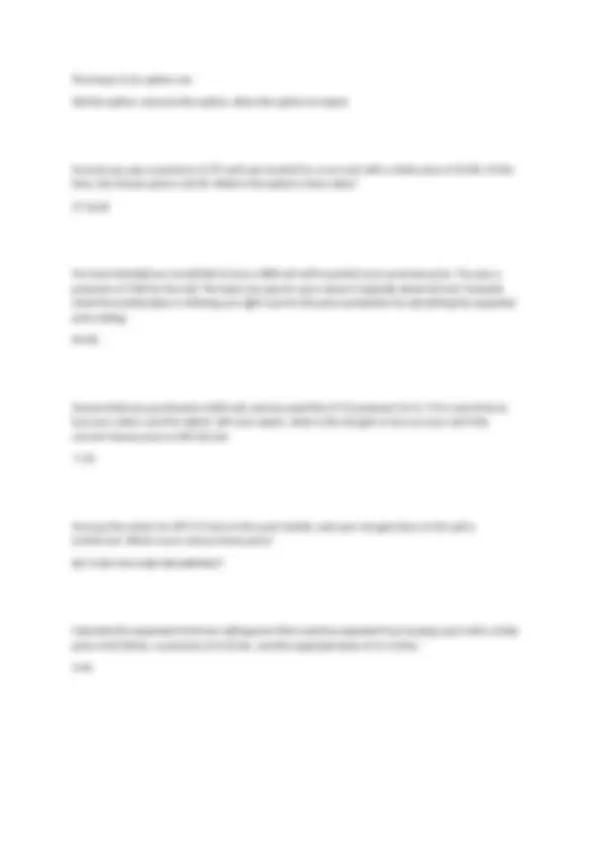
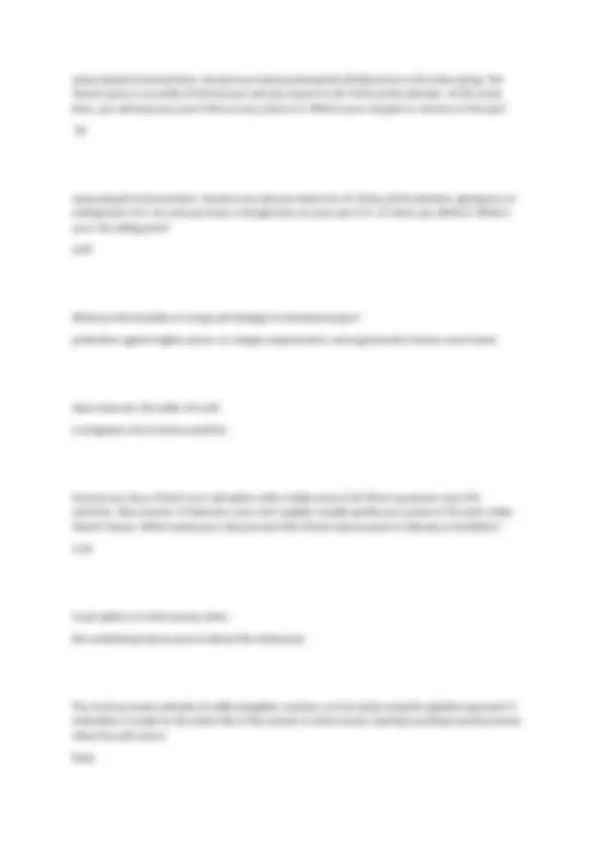
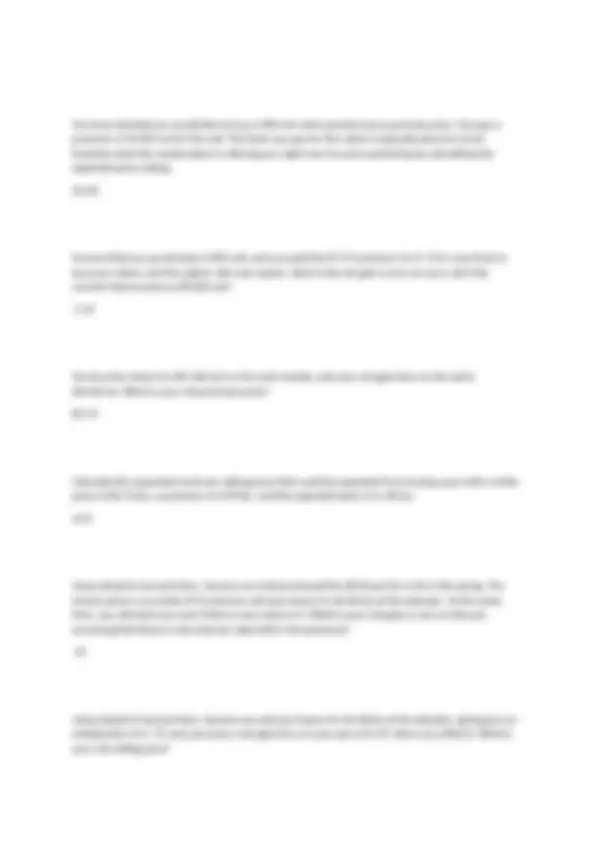
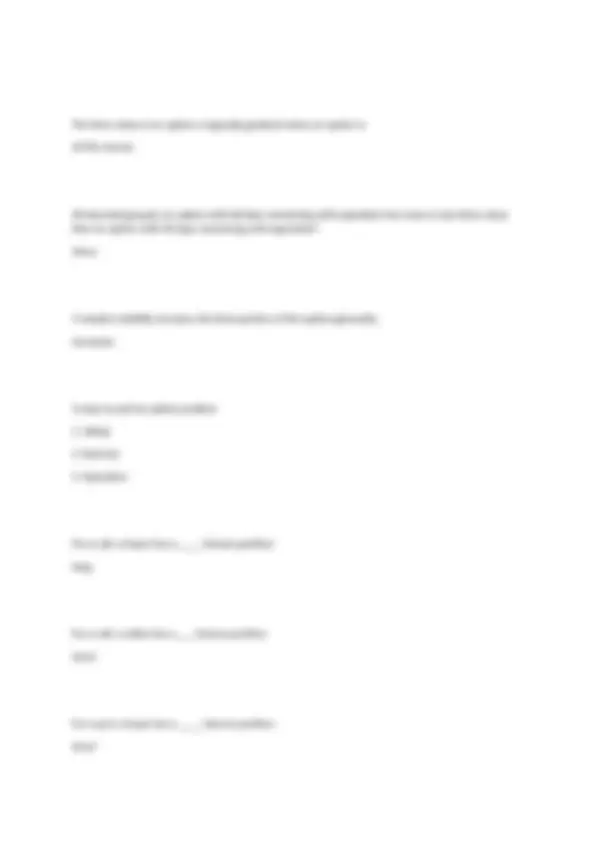
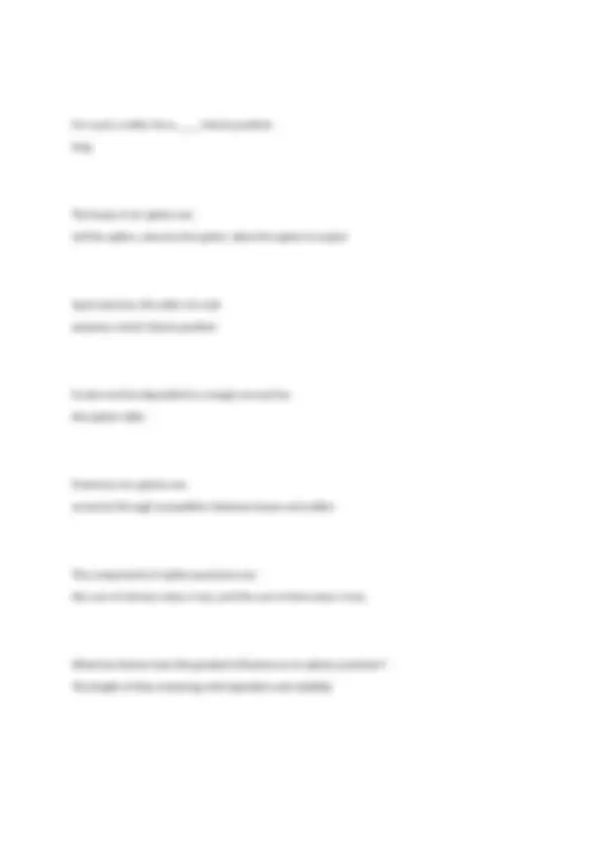
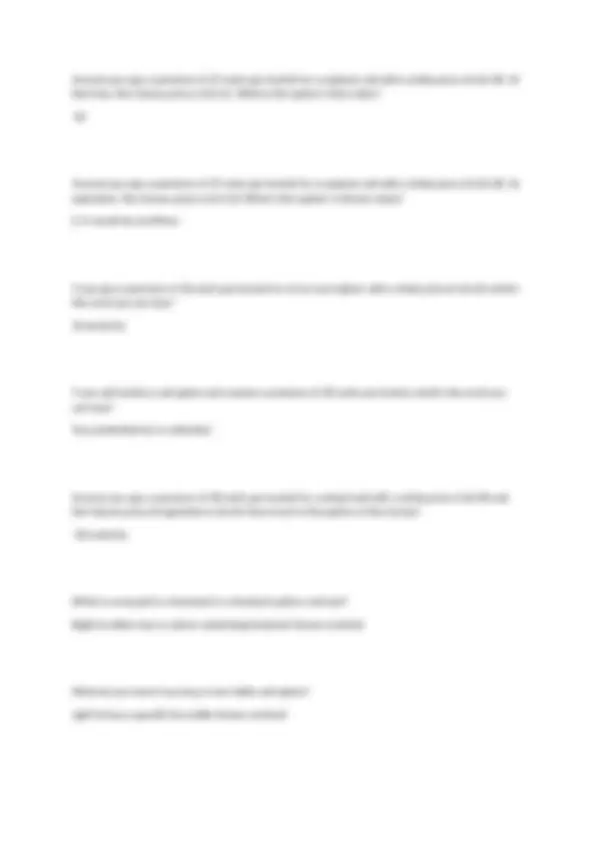
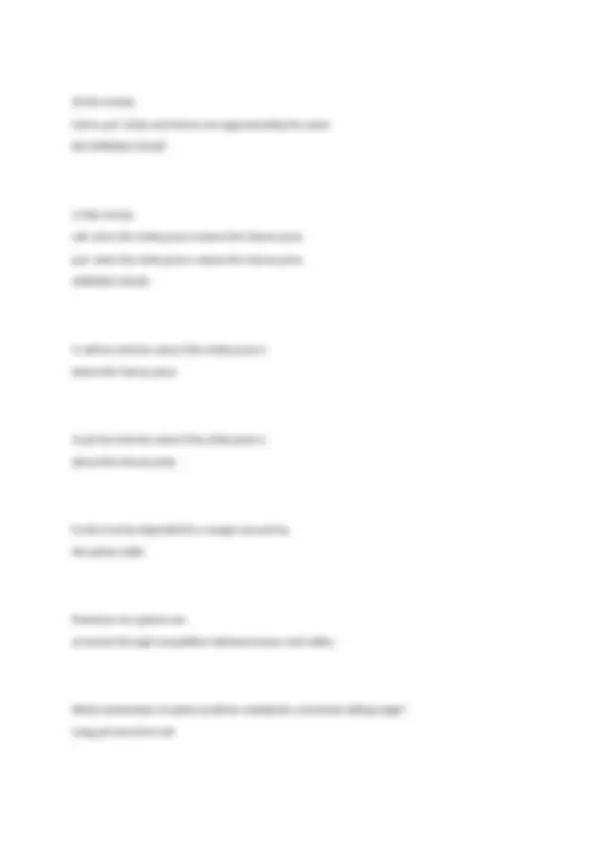
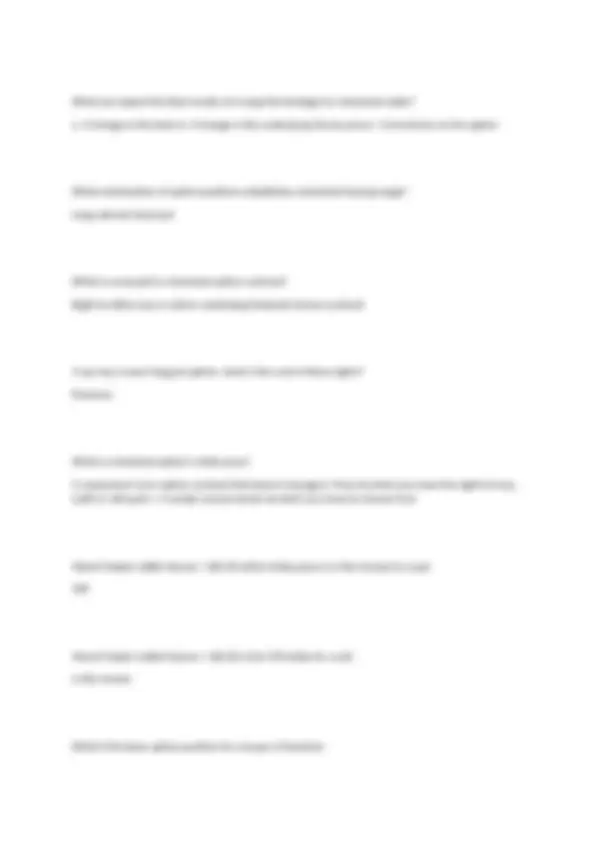
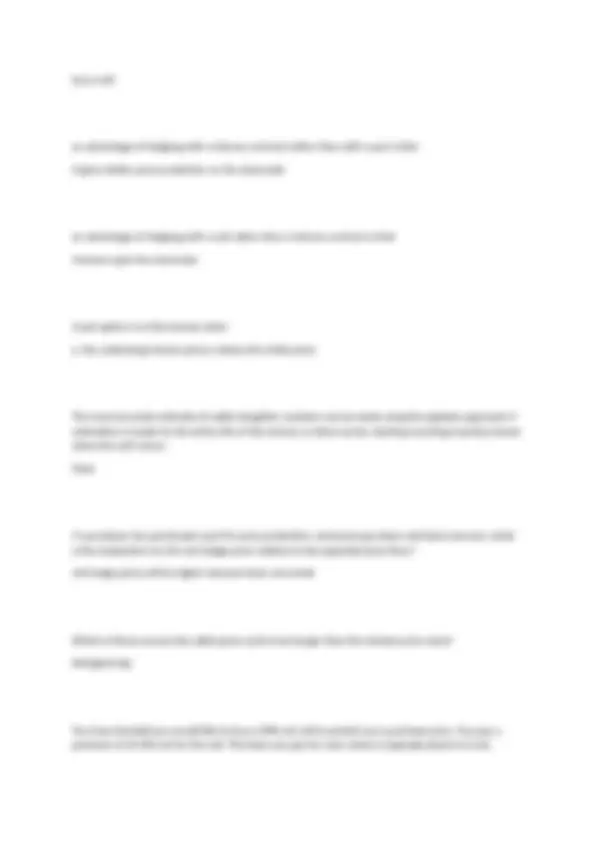


Study with the several resources on Docsity

Earn points by helping other students or get them with a premium plan


Prepare for your exams
Study with the several resources on Docsity

Earn points to download
Earn points by helping other students or get them with a premium plan
Community
Ask the community for help and clear up your study doubts
Discover the best universities in your country according to Docsity users
Free resources
Download our free guides on studying techniques, anxiety management strategies, and thesis advice from Docsity tutors
A series of questions and answers related to options and futures trading in the agricultural sector. It covers topics such as put and call options, strike prices, premiums, basis, and hedging strategies. Designed to help students understand the concepts and applications of options and futures in agricultural markets.
Typology: Exams
1 / 17

This page cannot be seen from the preview
Don't miss anything!










Jump ahead to harvest time. Assume you had purchased the $9.25 put for $.60 in the spring. The futures price is currently $7.80 and you sell your beans for $6.85/bu at the elevator. At the same time, you sell back your put if there is any value in it. What is your net gain or loss on the put, assuming that there is only intrinsic value left in the premium. . Jump ahead to harvest-time. Assume you sell your beans for $8.06/bu at the elevator, giving you an ending basis of -$.66, and you have a net gain/loss on your put of $1.75 when you offset it. What is your net selling price? Do not include units of measurement in your answer.
You buy the calves for $103.97/cwt on the cash market and your net gain/loss on the call is $9.40/cwt. What is your net purchase price? 113.37? CHECK IF YOU MUST ADD OR SUBTRACT Calculate the expected minimum selling price that could be expected from buying a put with a strike price of $5.25/bu, a premium of $.46/bu, and expected basis of $-1.20/bu.
You have decided you would like to buy a $80/cwt call to protect your purchase price. You pay a premium of $5.80/cwt for the call. The basis you pay for your calves is typically about $-7/cwt. Evaluate what the market price is offering you right now for price protection by calculating the expected price ceiling.
Assume that you purchased a $110 call, and you paid the $6.67 premium for it. If it is now time to buy your calves, and the option will soon expire, what is the net gain or loss on your call if the current futures price is $92.30/cwt? -6. What can impact the final results of a long call strategy for a livestock buying hedger? a change in basis? An advantage of hedging with a futures contract rather than with a put is that it is cheaper? If the underlying futures price moves up $1, the call option premium can generally be expected to increase in value? The time value of an option is typically greatest when an option is in the money ?? may be at the money A livestock producer interested in establishing a maximum purchase price for her upcoming feed needs would most likely: buy a call Assume you pay a premium of 13 cents per bushel for a January soybean call with a $6.40 strike price, and the basis is 20 cents over in December. What is the net price for soybeans if the January futures price in December is $6.80? 6.73?
Jump ahead to harvest time. Assume you had purchased the $9.00 put for $.36 in the spring. The futures price is currently $7.68 and you sell your beans for $6.73/bu at the elevator. At the same time, you sell back your put if there is any value in it. What is your net gain or net loss on the put? . Jump ahead to harvest time. Assume you sell your beans for $7.16/bu at the elevator, giving you an ending basis of $-.66, and you have a net gain/loss on your put of $-.27 when you offset it. What is your net selling price?
What are the benefits of a long call strategy for livestock buyers? protection against higher prices, no margin requirements, and opportunity if prices move lower Upon exercise, the seller of a call is assigned a short futures position Assume you buy a March corn call option with a strike price of $2.30 at a premium cost of 8 cents/bu. Also assume, in February, your corn supplier usually quotes you a price of 10 cents under March futures. What would your net price be if the March futures price in February is $2.80/bu?
A put option is in-the-money when: the underlying futures price is below the strike price The most accurate estimate of cattle slaughter numbers can be made using the pipeline approach if estimation is made for the entire life of the animal, in other words, starting counting inventory levels when the calf is born. False
You have decided you would like to buy a $90/cwt call to protect your purchase price. You pay a premium of $4.40/cwt for the call. The basis you pay for the calves is typically about $-2/cwt. Evaluate what the market place is offering you right now for price protecting by calculating the expected price ceiling.
Assume that you purchased a $105 call, and you paid the $7.27 premium for it. If it is now time to buy your calves, and the option will soon expire, what is the net gain or loss on your call if the current futures price is $94.80/cwt? -7. You buy the calves for $91.38/cwt on the cash market, and your net gain/loss on the call is $8.64/cwt. What is your net purchase price?
Calculate the expected minimum selling price that could be expected from buying a put with a strike price of $8.75/bu, a premium of $.99/bu, and the expected basis of $-.85/bu.
Jump ahead to harvest-time. Assume you had purchased the $8.50 put for $.63 in the spring. The futures price is currently $7.56 and you sell your beans for $6.85/bu at the elevator. At the same time, you sell back your put if there is any value in it. What is your net gain or loss on the put, assuming that there is only intrinsic value left in the premium? . Jump ahead to harvest-time. Assume you sell your beans for $6.58/bu at the elevator, giving you an ending basis of $-.73, and you have a net gain/loss on your put of $1.47 when you offset it. What is your net selling price?
A May corn put has a strike price of $5.80. The underlying May futures price is $5.55. The intrinsic value is: . A sept Soybean put has a strike price of $12.20. The underlying September futures price is $12.77. The intrinsic value is: 0 A $5.70 Dec Corn call is selling for a premium of 35 cents. At the time, Dec Corn futures are trading at $6.00. The time value is: . A $12.80 Nov Soybean put is selling for a premium of 3 cents. Nov Soybean futures are trading at $12.77. The time value is: 0 A Wheat call has a strike price of $6.70. At expiration, the underlying futures price is $6.80. The time value is: 0 Jul corn futures are trading at $6.00. A $5.50 July corn call is trading at a premium of 60 cents. The time value is: . Sept soybean futures are trading at $12.20. A $12.50 Sept soybean put is trading at a premium of 38 cents. The time value is: .
The time value of an option is typically greatest when an option is: at-the-money All else being equal, an option with 60 days remaining until expiration has more or less time value than an option with 30 days remaining until expiration? More If market volatility increase, the time portion of the option generally: increases. 3 ways to exit an option position
Assume you pay a premium of 27 cents per bushel for a soybean call with a strike price of $12.00. At the time, the futures price is $12.25. What is the option's time value? . Assume you pay a premium of 27 cents per bushel for a soybean call with a strike price of $12.00. At expiration, the futures price is $11.50. What is the option's intrinsic value? 0, it would be worthless If you pay a premium of 10 cents per bushel for a Corn put option with a strike price of $6.60, what's the most you can lose? 10 cents/bu If you sell (write) a call option and receive a premium of 30 cents per bushel, what's the most you can lose? Your potential loss is unlimited. Assume you pay a premium of 30 cents per bushel for a wheat call with a strike price of $6.00 and the futures price at expiration is $6.50. How much is the option in the money? .50 cents/bu What is conveyed in a livestock in a livestock option contract? Right to either buy or sell an underlying livestock futures contract What do you have if you buy a Live Cattle call option? right to buy a specific live cattle futures contract
At-the-money Call or put: strike and futures are approximately the same NO INTRINSIC VALUE In-the-money call: when the strike price is below the futures price put: when the strike price is above the futures price INTRINSIC VALUE A call has intrinsic value if the strike price is below the futures price A put has intrinsic value if the strike price is above the futures price Funds must be deposited to a margin account by the option seller Premiums for options are arrived at through competition between buyers and sellers What combination of option positions establishes a livestock selling range? Long put and short call
What can impact the final results of a Long Put strategy for a livestock seller? a. A change in the basis b. A change in the underlying futures price c. Commission on the option What combination of option positions establishes a livestock buying range? Long call and short put What is conveyed in a livestock option contract? Right to either buy or sell an underlying livestock futures contract If you buy a Lean Hog put option, what is the cost of these rights? Premium What is a livestock option's strike price? A component of an option contract that doesn't change b. Price at which you have the rights to buy (call) or sell (put) c. A variety of price levels at which you have to choose from March Feeder cattle futures = 182.20 which strike price is in the money for a put 184 March Feeder Cattle futures = 182.20 is the 178 strike for a call in the money What is the basic option position for a buyer of livestock
Evaluate what the market place is offering you right now for price protection by calculating the expected price ceiling.
Assume that you purchased a $105 call, and you paid the $7.27 premium for it. If it is now time to buy your calves, and the option will soon expire (which means there is only intrinsic value left in the premium), what is the net gain or loss on your call if the current futures price is $94.80/cwt? -7.
Jump ahead to harvest-time. Assume you sell your beans for $6.58/bu at the elevator, giving you an ending basis of $-0.73, and you have a net gain/loss on your put of $1.47 when you offset it. What is your net selling price?
Assume you buy a March corn call option with a strike price of $4.30 at a premium cost of 8 cents a bushel. Also assume, in February, your corn supplier usually quotes you a price of 10 cents under March futures. You purchase the corn at this price and offset your call. What would your net purchase price be if the March futures price in February is $4.80/bu?